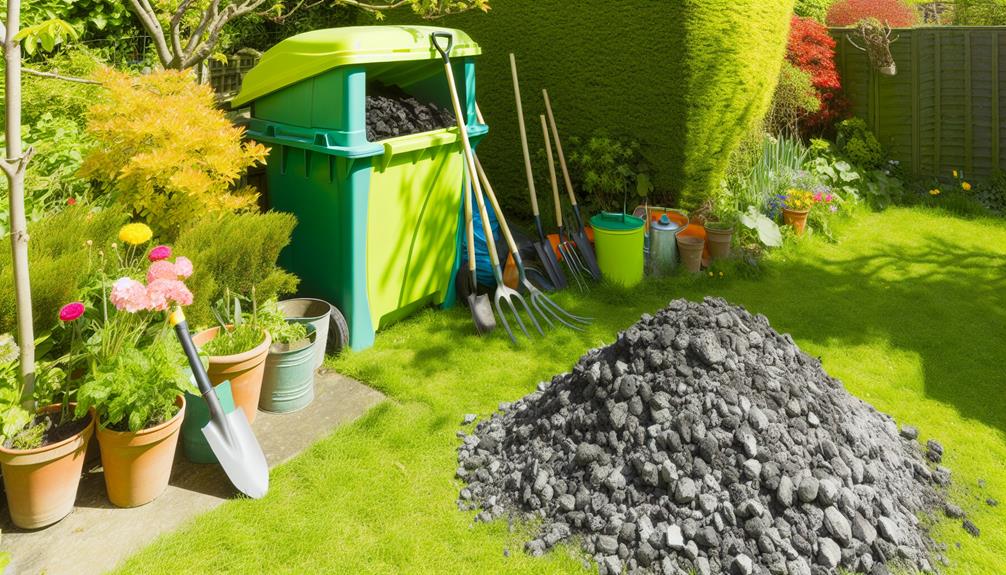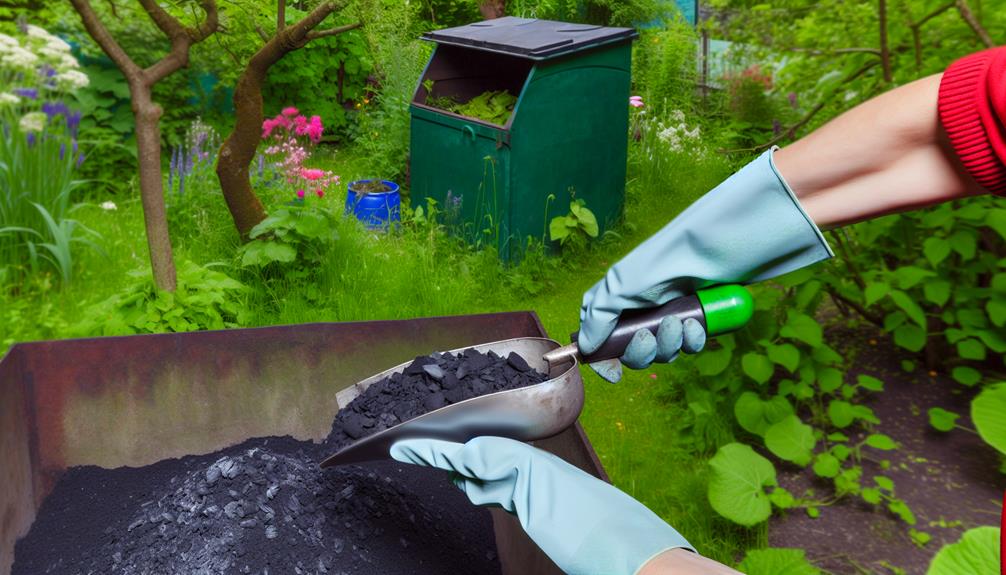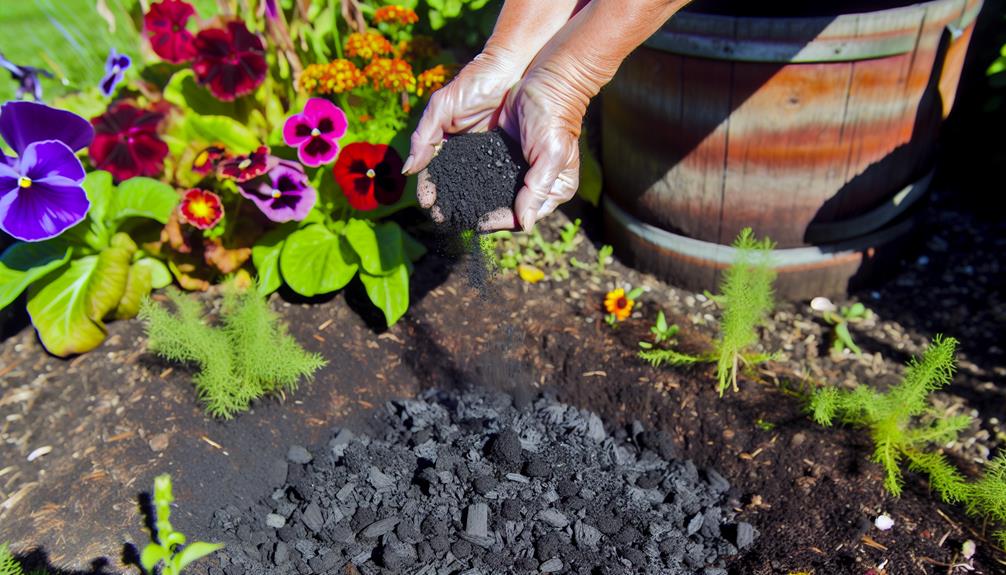

You can compost charcoal ash, but exercise caution. Make sure the ash is fully cooled before mixing it into your compost. Charcoal ash, rich in potassium and calcium, can act as a natural fertilizer. However, it may also raise soil pH, making it too alkaline for some plants and disrupting microbial activity.
Avoid using ash from briquettes with additives, as these can introduce harmful chemicals and heavy metals. Wear gloves and a mask when handling ash to prevent irritation. Mixing ash evenly and in moderation is key to maintaining a healthy compost balance. Explore further to get more composting tips and best practices.
Among the different types of charcoal, you’ll often come across lump charcoal and briquettes. Understanding these can enhance your grilling techniques and connect you with a community of barbecue enthusiasts.
Lump charcoal is made by burning wood in a low-oxygen environment, a process known as charcoal production. This type retains the natural shape and structure of the wood, offering a more authentic grilling experience. It’s favored for its ability to burn hotter and cleaner, providing those perfect sear marks on your steak.
On the other hand, briquettes are made from compressed sawdust and other wood by-products, combined with additives to maintain consistent burning. They’re popular for their uniform shape and steady burn time, making them a reliable choice for longer grilling sessions. While they may not reach the same high temperatures as lump charcoal, they provide a stable heat source, which is ideal for slow-cooking meats.
Whether you choose lump charcoal or briquettes depends on your grilling techniques and the flavor profiles you enjoy. Understanding the basics of charcoal production and the characteristics of each type can help you make the best choice for your next barbecue, creating a sense of camaraderie with fellow grillers.
Also Read: Can You Compost Wood Scraps?
Understanding the types of charcoal helps you appreciate the composition of the ash they leave behind. Different charcoals create ash with varying carbon content and inorganic elements, which directly impact its suitability for composting.
When you examine charcoal ash, you’ll find it primarily consists of:
Charcoal ash offers several key benefits that can enhance your compost and improve soil health. When you add charcoal ash to your compost pile, you’re providing a source of valuable nutrients that can act as a natural fertilizer. This ash contains important minerals such as potassium and calcium, which are essential for plant growth.

Moreover, the alkaline nature of charcoal ash can help to balance the pH levels in your soil, making it less acidic. This is particularly beneficial if you’re dealing with soil that has a low pH, as many plants thrive in a more neutral environment. Additionally, charcoal ash can improve the structure of your soil by increasing its ability to retain moisture and nutrients.
Here’s a quick table highlighting the benefits of charcoal ash:
| Benefit | Description |
|---|---|
| Nutrient-rich | Contains potassium and calcium |
| Natural fertilizer | Acts as a source of essential nutrients |
| pH balance | Helps to neutralize acidic soil |
| Soil structure | Enhances moisture and nutrient retention |
| Plant growth | Supports healthier and stronger plants |
Also Read: Can You Compost Cauliflower Scraps?
When composting charcoal ash, you need to be aware of potential drawbacks. Charcoal ash can alter the soil’s pH, making it more alkaline, which mightn’t be suitable for all plants.
Additionally, there’s a risk of heavy metal contamination, which can harm both soil health and plant growth.
While composting charcoal ash can enrich your soil, it’s important to be aware that it can also noticeably alter the soil’s pH levels. Charcoal ash is alkaline, and adding too much can make your soil less acidic. This shift in pH can have several potential drawbacks.
To avoid these issues, it’s essential to monitor your soil’s pH regularly. Mix charcoal ash with other compost materials and apply it sparingly. This ensures your garden remains a thriving, balanced ecosystem where everyone feels they belong.
Be mindful that composting ash can introduce heavy metals into your soil, posing significant risks to plant health and safety. Charcoal ash, especially from chemically treated wood, may contain heavy metals like cadmium, chromium, and lead. These contaminants can result in soil contamination, which can be detrimental to the overall ecosystem of your garden.
When heavy metals are present in your compost, they don’t just stay put. They’ve leaching effects, meaning they can gradually move through the soil and potentially reach water sources. This process can harm not only your plants but also the broader environment.
Plants absorbing these metals can suffer from stunted growth and reduced yields, and consuming produce from contaminated soil may pose health risks.
To minimize these risks, it’s advisable to test the ash for heavy metal content before adding it to your compost. Alternatively, you can limit the use of ash from unknown sources or treated wood. Sticking to small amounts of pure, untreated wood ash is a safer bet.
When handling charcoal ash, always wear protective gear like gloves and a mask to avoid skin irritation and inhalation of particles.

Guarantee the ash is completely cool before disposing of it to prevent any fire hazards.
Dispose of the ash properly, either by mixing it with compost in small amounts or placing it in a designated waste container.
Safely disposing of charcoal ash involves several key steps to prevent environmental harm and personal injury. First, it’s vital to follow your local municipal guidelines. These rules are designed to make sure that ash disposal is handled responsibly and safely. Always check if your community has specific instructions for handling charcoal ash, as they often do.
If your municipal guidelines permit, you can consider landfill disposal as an option. However, it’s important to prepare the ash properly before taking it to a landfill. Here are the steps you should follow:
Wearing the appropriate protective gear is vital when handling charcoal ash to avoid injuries and health issues. When you’re dealing with ash, it’s important to prioritize your safety.
First and foremost, always wear eye protection. Charcoal ash can easily become airborne, and small particles can irritate or damage your eyes. A good pair of safety goggles will keep your eyes safe from any unexpected ash clouds.
Next, fire resistant gloves are a must-have. Even if the ash appears cool, there might be hidden hot embers that can cause burns. Fire resistant gloves provide an extra layer of safety, ensuring you won’t get hurt while handling the ash. Look for gloves specifically designed for high-heat situations to get the best protection.
Additionally, wearing a long-sleeved shirt and pants is advisable. This will minimize skin exposure and reduce the risk of irritation or burns.
Also Read: Can You Compost Cedar Chips?
To effectively mix charcoal ash with your compost, start by ensuring the ash is fully cooled and free of any larger debris. Follow these composting guidelines to maintain the right compost ratios and create a balanced compost pile.
Also Read: Can You Compost Broad Beans?
In addition to composting, you can use charcoal ash in several other ways to benefit your garden and home.

One practical use is for odor control. Sprinkle a small amount of ash in areas prone to bad smells, such as trash cans or compost bins. The ash absorbs odors, keeping your environment fresh. Just be careful not to use too much, as it can make the area too alkaline.
Charcoal ash can also be a valuable addition to your garden. If you have acidic soil, a light dusting of ash can help balance the pH, making it more hospitable for a variety of plants. Be sure to test your soil first to avoid over-alkalization.
Another creative use for charcoal ash is in art projects. Mix the ash with water to create a natural, non-toxic paint or dye. This can be a fun, eco-friendly way to add unique touches to your crafts. You can also use the ash to create texture in your paintings or as a medium in pottery projects.
You’re wondering about the decomposition rate of charcoal ash in compost? Charcoal ash doesn’t undergo organic breakdown like other materials. It doesn’t decompose, so it’s best to use it sparingly to avoid disrupting your compost balance.
Yes, you can use charcoal ash in your vegetable garden, but be cautious. Ash application can raise soil pH, so test your soil first. Join fellow gardeners in ensuring the right balance for healthy plant growth.
When you use charcoal ash as a soil amendment, it benefits plants like tomatoes and carrots by adjusting the pH level. You’ll see healthier growth and feel part of a community that loves sustainable gardening!
It’s not safe to compost ash from chemically treated charcoal. Chemical residues can lead to soil contamination, harming your plants and garden ecosystem. Stick to natural wood charcoal to keep your compost and community garden healthy.
When adding charcoal ash, you should be cautious. Too much can raise soil pH and affect compost aeration. Limit it to a handful per compost layer to maintain balance and guarantee your garden thrives.
To sum up, you can compost charcoal ash, but it’s important to know the type of charcoal you’re using.
Avoid ash from treated charcoal due to harmful chemicals. Always handle ash safely, wearing gloves and ensuring it’s completely cool before mixing it with your compost.
Use it sparingly to balance pH levels and enrich your compost. Alternatively, consider using ash for pest control or soil amendment.
Follow these guidelines for safe and effective use.
